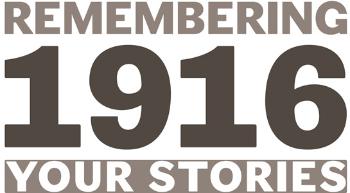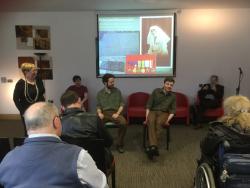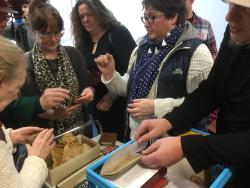March 2016
- 24-03-2016 - Remembering 1916: Your Stories
- 24 to 25-03-2016 - Revisiting Commemoration: Practices, uses and appropriations of the Centenary of the Great War’ conference, Université Paris Ouest Nanterre La Défense / Archives Nationales - Dr. Kurt Taroff
- 16-03-2016 - Living Legacies Engagement Day: Creative responses to First World War artefacts

Set within the context of world events of 1916, the Remembering 1916: Your Stories exhibition will acknowledge the importance of the Easter Rising and the Battle of the Somme as distinct events, while encouraging visitors to make new connections and appreciate the impact of the First World War on wider society.
Developed in collaboration with ‘Living Legacies 1914-18’, an innovative research initiative led by Queen’s University Belfast, the exhibition features artefacts which were donated by members of the public, as well as significant loans from the National Museum of Ireland and Imperial War Museum.
Rare and compelling objects including uniforms, equipment, medals, firearms, photographs, artwork, souvenirs and poignant personal mementoes, will be on view together for the first time, providing new insights into this defining period of our history. Many of these objects are directly connected to significant personalities. In relation to the Rising, this includes prominent northern republicans such as Denis McCullough, Roger Casement, Bulmer Hobson and Winifred Carney. In relation to the Battle of the Somme, the exhibition includes items associated with Major General Nugent, commander of the 36th (Ulster Division) and Lord Farnham, his aide-de-camp, alongside material reflecting the experience of both soldiers and nurses at the Front.
Highlights include a recently acquired Irish Volunteers tunic which will be displayed for the first time. This tunic belonged to Irish Volunteer Jack Greenan from Keady, Co. Armagh. His family believe Jack wore it while taking part in the Easter Rebellion of 1916. Also included are a blood-stained booklet that belonged to Private Adam Stewart from Co. Londonderry who was killed on the first day of the Battle of the Somme. There are two paintings of Thiepval by William Orpen - regarded as one of the most important war artists - on loan from the Imperial War Museum, as
well as an autograph book, on loan from the National Museum of Ireland, from Reading Jail which bears the signatures of Denis McCullough, Sean T. O’Kelly and Arthur Griffith.
William Blair, Head of History at National Museums Northern Ireland said: “The Easter Rising and the Battle of the Somme appear to lie at opposite ends of our political spectrum, but they are linked by the First World War and the profound social and political change that it brought about. Both the Easter Rising and the Battle of the Somme form an important part of the complex weave of history that continues to influence our present and our future.”
Mr Blair added, “Our collection, largely donated to the museum during and immediately after the First World War, reflects what people believed to be important and worth preserving. Since 2014 we have also been collecting family histories through the Living Legacies 1914-18 Engagement Centre and it has been wonderful to work with academics from Queen’s University Belfast as well as the public to create a truly collaborative exhibition combining leading-edge research with human stories.”
Prof. Keith Lilley, Director of Living Legacies 1914-18 Engagement Centre said: “Remembering 1916: Your Stories is a remarkable exhibition that combines personal items drawn from communities across Northern Ireland and places these alongside material from museum collections. The exhibition marks a significant point in an ongoing collaboration between National Museums Northern Ireland and the Living Legacies 1914-18 WW1 public engagement centre, based at Queen’s University Belfast.”
Prof. Lilley added, “The exhibition offers us the opportunity not only to understand the war and its impacts in new ways, it also provides a model of co-curation and participatory research that deepens meaningful links between museums, universities and local communities. Out of the trauma of war, Remembering 1916: Your Stories draws us all together.”
Remembering 1916: Your Stories exhibition will complement wider initiatives associated with the Decade of Centenaries including the Royal Irish Academy 1916 Portraits and Lives photographic exhibition on display until 3 April in the Belfast Room at the Ulster Museum.
Remembering 1916: Your Stories exhibition will run until 2017. The exhibition will be accompanied by a series of talks and curator-led tours, workshops, film screenings and family activity events.
Abstract taken from http://nmni.com/Home/News/Ulster-Museum-1916-Centenary
For more information please visit the Remembering 1916 : Your Stories
Revisiting Commemoration: Practices, uses and appropriations of the Centenary of the Great War’ conference, Université Paris Ouest Nanterre La Défense / Archives Nationales - Dr. Kurt Taroff
On 24-25 March 2016, I attended ‘Revisiting Commemoration: Practices, Uses and Appropriations of the Centenary of the Great War’, a conference jointly organised by Valérie Tesnière of the International Contemporary Documentation Library and Sarah Gensburger of the Institute for the Social Sciences of Politics in Paris. The first day of the conference was held at University Paris West, Nanterre, with the second day at the behemoth National Archives building in Saint Denis.
The organisers of the conference looked back to the bicentennial commemorations of the French Revolution in 1989 (and the academic considerations of that commemoration that have followed) as a starting point to consider what commemoration practices can tell us about contemporary society and the ways in which collective memory simultaneously structures and is structured by our interpretation of history.
Among the papers at the conference, one recurring strand focused on digital humanities, and the ways in which we can trace public engagement with First World War commemoration through the prevalence of tweets on the subject as well as in the network of websites that has grown around the centenary period. In addition, the entirety of the final afternoon’s session was dedicated to the question of commemorating WWI in schools, including different methods for getting teenage (and younger) students engaged with the process, dealing with ‘inappropriate’ responses (i.e., laughing) to difficult material by students, and, intriguingly, using the militant wartime propaganda of othering as a way to get students from varying backgrounds and nationalities to see the dangers (and spuriousness) of such rhetoric.
Not surprisingly, the UK was well-represented, with essays by Jenny Kidd and Joanne Sayner on the resent poppy commemoration at the Tower of London and Anne-Marie Kramer on various practices of commemoration in the UK and ordinary peoples’ responses to those practices. Both of these essays ultimately deal with public responses to commemoration that do not necessarily conform to official narratives of patriotism and noble sacrifice. Both Sayner and Kramer, it should be noted, are linked to other First World War Engagement Centres, Sayner with Birmingham, and Kramer with Hertfordshire. In a similar vein, my own essay, on the commemoration parades in Belfast celebrating the UVF centenary, along with Jonathan Evershed and Jason Burke’s presentation on their work on the East Belfast and the First World War Project, combined to show the complications surrounding First World War commemoration in the context of continuing political machinations in Belfast today.
In the context of the issue of contested commemoration in Belfast, two other papers stood out as of interest in a similar vein. Marnix Beyen and Laurence van Ypersele spoke of the complications of First World War commemoration in Belgium where the Flemish and French-speaking communities hold starkly different views on the legacy of the war and how it should be remembered. And in an extremely interesting presentation, Sofia Tchoukina explored the rapid transformation of the First World War in Russian politics and the public imagination. She noted that under the Soviets the First World War was largely ignored, both in favour of the Second World War and also as an imperialist war fought only for the benefit of the Tsar and the bourgeoisie. However, in Putin’s Russia, against the backdrop of centenary commemorations being undertaken across Europe, the First World War has been rehabilitated as a great victory, in which the great Russian soldiers, unified by the benevolent Tsar and the Orthodox Church (in keeping with the church’s return to the fore of contemporary Russian life and politics) saved France and Britain from the Germans, with the fruits of this great victory then stolen from the Russian people by the Bolsheviks.
With a variety of presentations representing a broad cross-section both geographically and in subject matter, Revisiting Commemoration offered an outstanding opportunity to get a glimpse of the ways in which First World War commemoration is taking place and being critiqued across Europe. As is often the case, it raised many further questions to be explored over the next several years, and well beyond.
Living Legacies Engagement Day: Creative responses to First World War artefacts
Wednesday 16 March 2016
 The engagement day 'Creative Responses to First World War artefacts' is part of an ongoing relationship between Living Legacies and the Fermanagh Writers. This relationship began with a presentation given by Elizabeth Crooke to the group Spring 2015 on the same theme. We built on this via the Music and Memories event in The Inniskillings Museum (25 June 2015), which was attended by the Writers along with other members of the public.The focus of the Engagement Day (16 March 2016) was to explore approaches to the interpretation of First World War collections. There were three parts to the day: Visit to Northern Ireland War Memorial; attendance at MARRI event at Imagine! Belfast’s Festival of Ideas and Politics; and an afternoon workshop with Brenda Winter Palmer. The focus of each was how others have engaged with the material culture of the First World War and exploring approaches that would be useful to the Writers. At the NIWM the group was welcomed by Ian Wilson (Chairperson Board NIWM), he spoke on the importance of thinking in innovative ways with museum collections and using the Decade of Centenaries to reach out to new audiences. This was followed by a workshop and object handling session with the Curator, Ciaran Doran. The Curator spoke about how the museum engages with artefacts and their donors. She talked about the objects and allowed them handle museum collections from the period and together we explored how creatively think about the objects. This continued into the afternoon sessions when Writer and Director Brenda Winter Palmer explored with the Writers how to creatively respond to original sources.
The engagement day 'Creative Responses to First World War artefacts' is part of an ongoing relationship between Living Legacies and the Fermanagh Writers. This relationship began with a presentation given by Elizabeth Crooke to the group Spring 2015 on the same theme. We built on this via the Music and Memories event in The Inniskillings Museum (25 June 2015), which was attended by the Writers along with other members of the public.The focus of the Engagement Day (16 March 2016) was to explore approaches to the interpretation of First World War collections. There were three parts to the day: Visit to Northern Ireland War Memorial; attendance at MARRI event at Imagine! Belfast’s Festival of Ideas and Politics; and an afternoon workshop with Brenda Winter Palmer. The focus of each was how others have engaged with the material culture of the First World War and exploring approaches that would be useful to the Writers. At the NIWM the group was welcomed by Ian Wilson (Chairperson Board NIWM), he spoke on the importance of thinking in innovative ways with museum collections and using the Decade of Centenaries to reach out to new audiences. This was followed by a workshop and object handling session with the Curator, Ciaran Doran. The Curator spoke about how the museum engages with artefacts and their donors. She talked about the objects and allowed them handle museum collections from the period and together we explored how creatively think about the objects. This continued into the afternoon sessions when Writer and Director Brenda Winter Palmer explored with the Writers how to creatively respond to original sources.
 On Facebook the Fermanagh Writers described the impact of the workshops 'it was a great day indeed. Thank you so much Elizabeth for organising it. I am sure that the fruits of the day will be a lot of creative activity. I know that some of us are already planning on another visit to the War Memorial. We have a lot of fascinating information to digest and process. Thanks to all at both venues for the experience'. Since the event one of the participants wrote a blog post of her visit on the site, noting 'for me, getting up close to real objects is a great way to set a story in motion'. To see her entire post click here http://www.writersabroad.com/pt/The-Real-Thing.3-21-2016/blog.htm
On Facebook the Fermanagh Writers described the impact of the workshops 'it was a great day indeed. Thank you so much Elizabeth for organising it. I am sure that the fruits of the day will be a lot of creative activity. I know that some of us are already planning on another visit to the War Memorial. We have a lot of fascinating information to digest and process. Thanks to all at both venues for the experience'. Since the event one of the participants wrote a blog post of her visit on the site, noting 'for me, getting up close to real objects is a great way to set a story in motion'. To see her entire post click here http://www.writersabroad.com/pt/The-Real-Thing.3-21-2016/blog.htm
.
|
This video shows "Living Legacies Engagement Day: Creative responses to First World War artefacts" which was on Wednesday 16 March 2016 and focused on three parts:
|
|
